Poker Tournament Models
- Poker Tournament Sacramento
- Poker Tournament Series
- Poker Tournament Models 2020
- Poker Tournament Structure
Clément Sire isn't just a statistical physicist—he's also a champion bridge player. Combining his love of physics and games, he has created a model of the poker variant Texas hold 'em that enables him to do everything from predicting the length of a tournament to figuring out his ranking simply by assessing the average size of his opponents' fortunes.
It may seem like an odd way to spend his time. After all, isn't physics supposed to be about particle colliders and superconductivity? 'Physicists,' Sire explains, 'are now more than ever involved in the study of complex systems that do not belong to the traditional realm of their science.'
Poker Tournament Sacramento
What Is The Independent Chip Model (ICM)? How to use ICM Easy-to-understand guides for the independent chip model (ICM) in poker are few and far between, so I'm going to try hard to keep this article as concise and relevant to improving your Sit and Go tournament game as possible.
Sire, of the Laboratory of Theoretical Physics, University of Toulouse, France, published his work Universal Statistical Properties of Poker Tournaments on arXiv.org. He used real data from online poker tournaments and found that it matched the results of his model.
- The international community has decided their players for the 2020 Hybrid WSOP Championship Event. Now it is the States of America’s turn to decide. This Sunday, WSOP.com in both New Jersey.
- There exist various poker ICM models which differ from each other by their approach to calculating the probabilities of each stack finishing at each potential position. The most popular and proven ICM poker model that is generally considered as the ICM poker model is the Malmuth-Harville model. Why do we use ICM In Tournament Poker?
- Players who have solid poker fundamentals will often make a major mistake in poker tournaments that they don't make in cash games. That mistake is being too patient. In a cash poker game, the goal (especially at low limits) is often to wait for a good hand, a good flop and a bad opponent to pay you out.
- In the model, poker hands are represented by a random value between 0 (bad) and 1 (best possible). The 'blind,' or minimum, bet for any table of 10 players gradually increases as the tournament.


'What's exceptional about this paper is that Clément somehow took what seems to be a complex and mysterious system and quantified it [with the tools of statistical mechanics] in a very precise way,' says Sidney Redner, a physicist at Boston University who works on related problems.
Poker is an especially attractive subject, because it's one of the few truly isolated systems. Unlike, say, the stock market, which is often governed by factors such as politics, war and weather, poker tournaments are not affected by external phenomena. As a result, even Sire's simplified model of Texas hold 'em appears to mathematically express many features of the game that experienced players would recognize.
In the model, poker hands are represented by a random value between 0 (bad) and 1 (best possible). The 'blind,' or minimum, bet for any table of 10 players gradually increases as the tournament progresses. In any given hand, players can either fold, bet the blind, or go 'all-in,' as in bet all of their chips.
Sire's model includes functions that reproduce the most basic tasks a poker player must carry out, such as deciding whether to bet strictly on the strength of his or her hand. Using the model, Sire discovered that there is an optimal value for a player's tendency to go all-in. This value, which he calls q, varies depending on whether a player has few or many chips. But any player, whose average tendency to bet the farm deviates from q, is going to win less often than a player whose tendency to go all-in is closer to q, he says.

Predicting Rank
One feature of Sire's model came directly from his own experience playing in poker tournaments. 'I noticed when playing that when I had twice the number of chips as the average,' he says, 'I was typically in the 10 best people of a 100-person tournament.'
Curious, he used data from his model to graph the rankings of players versus the number of chips they held. He found that his anecdotal observations were correct and, also, that his model almost perfectly matched the data he had gathered from online poker tournaments.
You're Only as Rich as the Size of Your Tournament
Sire also discovered that the maximum number of chips held by the 'chip leader,' or the player with the most chips at any given time, as well as the total number of chip leaders, are both a function of the number of players who enter a tournament. (Specifically, they're proportional to the logarithm of the initial number of players.)
'This phenomenon has been observed in many different models involving competing agents,' Sire notes. 'In models of biological evolution, it shows up where you have many species who compete and there is one prominent, or leading, species.'
Instinctive Math
In Internet Texas hold 'em poker tournaments, the minimum bet goes up exponentially over time, which means that it increases by a factor of 10 every hour or two. Tournament organizers do this to ensure that tournaments with 10,000 players don't take 100 times longer to complete as those with only 100 players.
'The increase of the [minimum bet] in tournaments is only to ensure that the number of players decreases sufficiently fast,' Sire says. 'What's interesting is that organizers must intuitively know this, even though they don't know the math behind it. Essentially they have estimated the rate at which they should increase the blind, but with [my model] they can control very accurately the duration of the tournament.'
Winning with Physics
Sire's ability to reproduce many of the characteristics of a poker tournament indicates that, when taken as a whole, the features of these tournaments are entirely predictable. Before anyone attempts to use Sire's model to plot a winning strategy, however, they should take heed of Sire's findings.
It turns out that the distribution of the 'stack,' or fortune, of the chip leaders across tournaments mirrors the pattern found in the distribution of maximum temperatures during every August in history or countless other natural phenomena where physicists have attempted to predict the nature of extreme values. This pattern, called the Gumbel distribution, means that the frequency with which chip leaders accrue fortunes of any given size is, in a way, a natural phenomenon that arises as much from the characteristics of the game being played as from the dispositions and abilities of those playing it.
'To have the Gumbel distribution show up here makes sense in hindsight,' says Redner, 'but it is beautiful to see someone find it in this area for the first time.'
Poker Tournament Series
In poker, the Independent Chip Model (ICM) is a mathematical model used to calculate a player's overall equity in a tournament. The model uses stack sizes alone to determine how often a player will finish in each position (1st, 2nd, etc.). A player's probability of finishing in each position is then multiplied by the prize amount for that position and those numbers are added together to determine the player's overall equity.[1][2]
The term ICM is often misunderstood to mean a simulator that helps a player make decisions in a tournament. Such simulators often make use of the Independent Chip Model but are not strictly speaking ICM calculators. A true ICM calculator will have the chip counts of all players, as well as the payout structure of the tournament, as input and each player's equity as output.[3]
The ICM can be applied to answer specific questions, such as:[4][5]
- The range of hands that a player can move all in with, considering the action so far and the stack sizes of the other players still in the hand
- The range of hands that a player can call another player's all in with, and recommends either calling or moving all in over the top, considering all the stacks still in the hand
- When discussing a deal, how much money each player should get
References[edit]
- ^Fast, Erik (2012-03-20). 'Poker Strategy -- Introduction To Independent Chip Model With Yevgeniy Timoshenko and David Sands'. cardplayer.com. Retrieved 12 September 2019.
- ^'ICM Poker Introduction: What Is The Independent Chip Model?'. Upswing Poker. Retrieved 12 September 2019.
- ^Walker, Greg. 'What Is The Independent Chip Model?'. thepokerbank.com. Retrieved 12 September 2019.
- ^Selbrede, Steve (2019-08-27). 'Weighing Different Deal-Making Methods at a Final Table'. PokerNews. Retrieved 12 September 2019.
- ^Card Player News Team (2014-12-28). 'Explain Poker Like I'm Five: Independent Chip Model (ICM)'. cardplayer.com. Retrieved 12 September 2019.
Further reading[edit]
Poker Tournament Models 2020
- Harrington, Dan; Robertie, Bill (2014). Harrington On Modern Tournament Poker. Two Plus Two Publishing LLC. ISBN1-880685-56-6. Harrington discusses the ICM on pages 108-122.
- Collin Moshman (July 2007). Sit 'n Go Strategy: Expert Advice for Beating One-Table Poker Tournaments. Two Plus Two Publishing LLC. pp. 122–. ISBN978-1-880685-39-6.
- Jonathan Grotenstein; Storms Reback (15 January 2013). Ship It Holla Ballas!: How a Bunch of 19-Year-Old College Dropouts Used the Internet to Become Poker's Loudest, Craziest, and Richest Crew. St. Martin's Press. pp. 17–. ISBN978-1-250-00665-3.